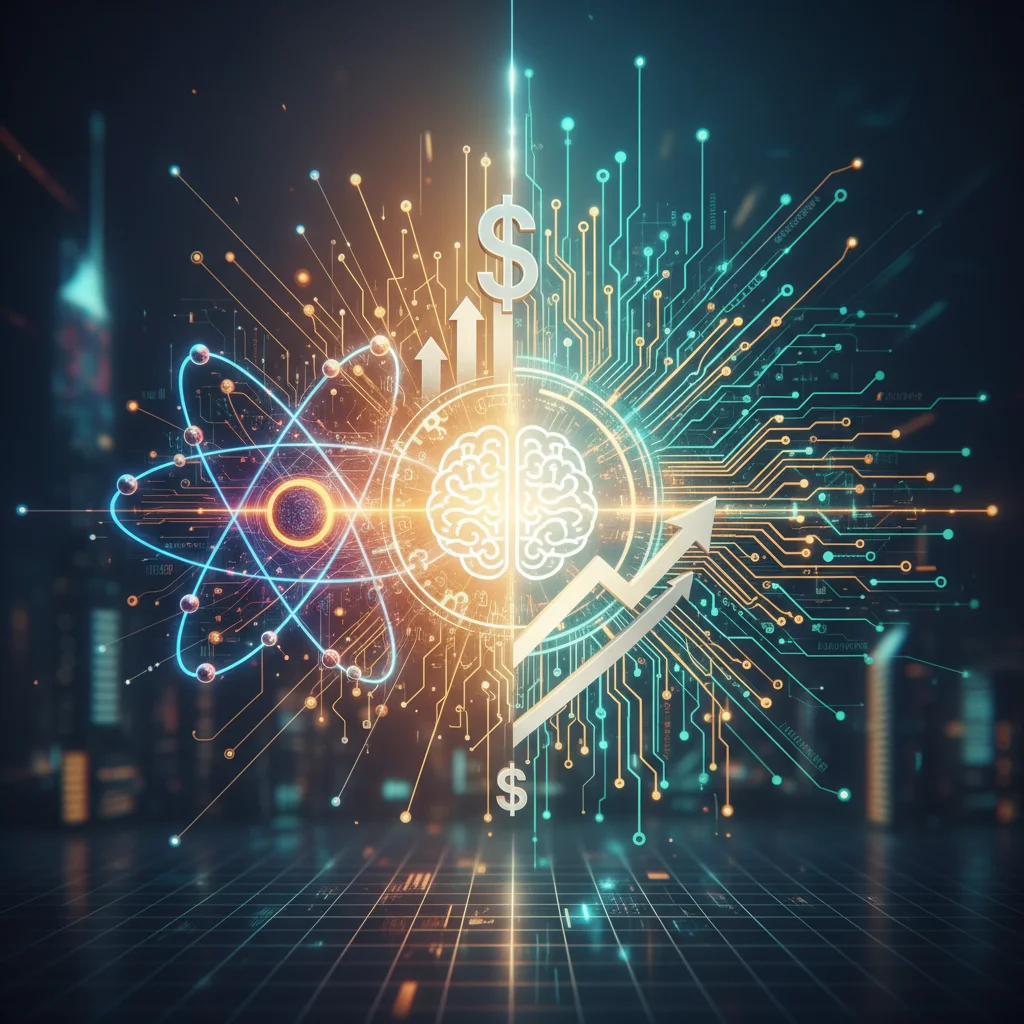
The Atom and the Algorithm: Why Wall Street and Big Tech Are Betting on Nuclear to Power the AI Revolution
We stand at the dawn of an incredible new era, one defined by the transformative power of artificial intelligence. From the large language models (LLMs) that answer our queries to the generative art that fills our screens, AI is rapidly reshaping our world. But behind the seamless interfaces and magical outputs lies a voracious, and often overlooked, appetite: an insatiable hunger for energy.
Every time you prompt an AI, you’re spinning up a global network of powerful servers packed with energy-guzzling GPUs. The training of a single major AI model can consume as much electricity as 100 U.S. homes do in an entire year. As the AI and machine learning boom accelerates, the question is no longer just about writing better code; it’s about finding the raw power to run it. The world’s data centers, the physical heart of the cloud and SaaS industries, are straining our electrical grids to their limits.
According to some projections, the electricity consumption of data centers could triple to 7.5% of total U.S. demand by 2030. This isn’t just a problem; it’s an existential threat to the continued growth of the digital economy. So, where will all this power come from? The answer, surprisingly, might lie in a technology many had written off: nuclear energy.
In a move that signals a seismic shift in investment strategy, nuclear reactor developer X-energy has just closed a new fundraising round, attracting backing from an unexpected source: the high-frequency trading firm Jane Street. This isn’t just another venture capital deal; it’s a powerful statement that the worlds of high finance, cutting-edge software, and deep-tech energy are converging to solve the single biggest bottleneck facing the AI revolution.
The AI Energy Crisis: More Than Just a High Electric Bill
To understand why a Wall Street firm is investing in nuclear reactors, we first need to grasp the sheer scale of AI’s energy problem. Unlike traditional computing, which has become remarkably efficient over the years, the computational demands of modern AI are astronomical. Training models like GPT-4 involves processing trillions of data points, a task that requires massive, sustained power draws for weeks or even months.
But it’s not just training. The “inference” stage—the part where the AI actually does its work, like generating text or an image for a user—is a constant, 24/7 energy drain. As AI becomes integrated into everything from enterprise automation to consumer apps, this baseline energy demand is set to explode. This creates a trilemma for tech giants and startups alike:
- Scalability: Can we physically build data centers and power infrastructure fast enough to keep up with demand?
- Cost: How do we prevent the cost of energy from making AI services prohibitively expensive?
- Sustainability: How do we power this revolution without derailing climate goals and relying on fossil fuels?
Renewable sources like solar and wind are crucial, but they are intermittent. They can’t provide the kind of reliable, 24/7 “baseload” power that a massive data center requires to operate without interruption. This is the critical gap that a new generation of nuclear technology promises to fill.
From Racetrack to Railway: How Formula 1 AI is Fixing Your Terrible Train Wi-Fi
A Nuclear Renaissance: Introducing Small Modular Reactors (SMRs)
When you hear “nuclear power,” you probably picture the colossal cooling towers and sprawling complexes of the 20th century. But the technology attracting investors today is a different beast entirely. Meet the Small Modular Reactor, or SMR.
X-energy, the company at the center of this new funding round, is a leader in this space. They are developing the Xe-100, a high-temperature gas-cooled reactor. Instead of huge, custom-built projects that take decades and tens of billions of dollars to construct, SMRs are designed to be smaller, safer, and—crucially—manufactured in a factory and assembled on-site. This approach dramatically changes the economics and scalability of nuclear power.
The Xe-100, for instance, uses a “pebble bed” design where the nuclear fuel is encased in thousands of graphite spheres, a design that proponents claim is inherently meltdown-proof. It’s this kind of innovation that is changing perceptions and attracting serious capital.
To put the shift in perspective, let’s compare the old with the new:
| Feature | Traditional Nuclear Plants | Small Modular Reactors (SMRs) |
|---|---|---|
| Power Output | 1,000+ Megawatts (MW) | Typically under 300 MW per module |
| Construction | Custom, on-site construction over 10+ years | Standardized, factory-built modules assembled on-site |
| Footprint | Vast, requiring hundreds of acres | Small, can be sited in more locations |
| Cost | Tens of billions, high risk of overruns | Lower upfront cost per module, more predictable |
| Use Case | Grid-scale electricity for entire regions | Powering data centers, industrial sites, or remote communities |
| Safety | Active safety systems (pumps, generators) | Passive safety systems (rely on physics, not mechanics) |
Follow the Money: A New Breed of Investor Emerges
X-energy’s latest $80 million fundraising round is fascinating not just for the amount, but for who is writing the checks. The participation of Jane Street, a quantitative trading powerhouse known for its sophisticated algorithms and data-driven decisions, is a powerful signal. This isn’t a sentimental bet; it’s a calculated one. Firms like Jane Street model the future, and their models are clearly pointing to a massive, long-term energy deficit that only next-generation nuclear can solve.
They aren’t alone. X-energy already counts Jeff Bezos and major industrial players like Dow among its backers. Dow plans to use X-energy’s first four-reactor plant at one of its sites in Texas to provide clean, reliable heat and power for its chemical manufacturing processes, with a target operation date of 2030 (source). This provides a concrete, real-world customer, moving the technology from theory to commercial reality.
Furthermore, the U.S. government is heavily de-risking these ventures. X-energy has already received over $1.2 billion in funding from the Department of Energy, providing a stable foundation of public capital that makes private investment far more palatable. It’s a classic public-private partnership aimed at solving a national-level challenge in technology and infrastructure.
What’s truly fascinating here is the collision of cultures. You have the move-fast-and-break-things ethos of the tech world and the hyper-analytical, risk-modeling mindset of Wall Street crashing into the slow, meticulous, and heavily regulated world of nuclear engineering. The success of this entire endeavor will hinge on whether these disparate fields can find a common language and operational rhythm. My prediction? We’ll see more failures before we see widespread success, but the projects that do cross the finish line won’t just power data centers; they will fundamentally re-wire the relationship between technology and energy for the 21st century. This is less of a guaranteed bet and more of a calculated, generational moonshot.
What This Means for the Future of Technology
This convergence of AI, finance, and nuclear energy has profound implications across the tech landscape, from the largest cloud provider to the individual developer.
- For Developers and Programmers: The underlying infrastructure you build upon is undergoing a radical transformation. In the future, the efficiency of your programming and the architecture of your software could be influenced by energy availability and cost. We may see the rise of “energy-aware” computing, where workloads are shifted to data centers with access to cheaper, cleaner power.
- For Startups and Entrepreneurs: A massive new ecosystem is emerging. Opportunities will abound for startups focused on data center energy efficiency, advanced cooling systems, automation software for managing power grids, and, critically, cybersecurity solutions to protect this new generation of critical nuclear infrastructure.
- For the Cloud and SaaS Industry: The geographical map of the cloud may be redrawn. Instead of clustering data centers near existing population centers and internet backbones, we might see them co-located with new SMRs in more remote locations. This could create a more resilient, decentralized internet, but also new challenges in data latency and connectivity.
The £20,000 Gadget That Hijacks Your Car: A Deep Dive into the Cybersecurity Arms Race
The Atom is the New Foundation for the Bit
The story of X-energy’s funding is more than just a financial headline. It’s a glimpse into the future of infrastructure. For decades, the tech revolution has been built on the relatively invisible and seemingly infinite resources of electricity and computing power. That era is ending.
The AI revolution is forcing a reckoning with the physical world. It’s a stark reminder that every line of code, every algorithm, and every bit of data has a real-world energy cost. The bold bet being made by Jane Street, Jeff Bezos, and the U.S. government is that the immense, concentrated power of the atom is the only logical and scalable solution to power the immense, distributed intelligence of AI.
Will it work? The challenges are undeniable. But as the demand for artificial intelligence continues its exponential climb, the search for a power source that is clean, reliable, and powerful enough to sustain it is leading us back to the atom. The fusion of nuclear energy and artificial intelligence may just be the defining technological partnership of the coming century.


